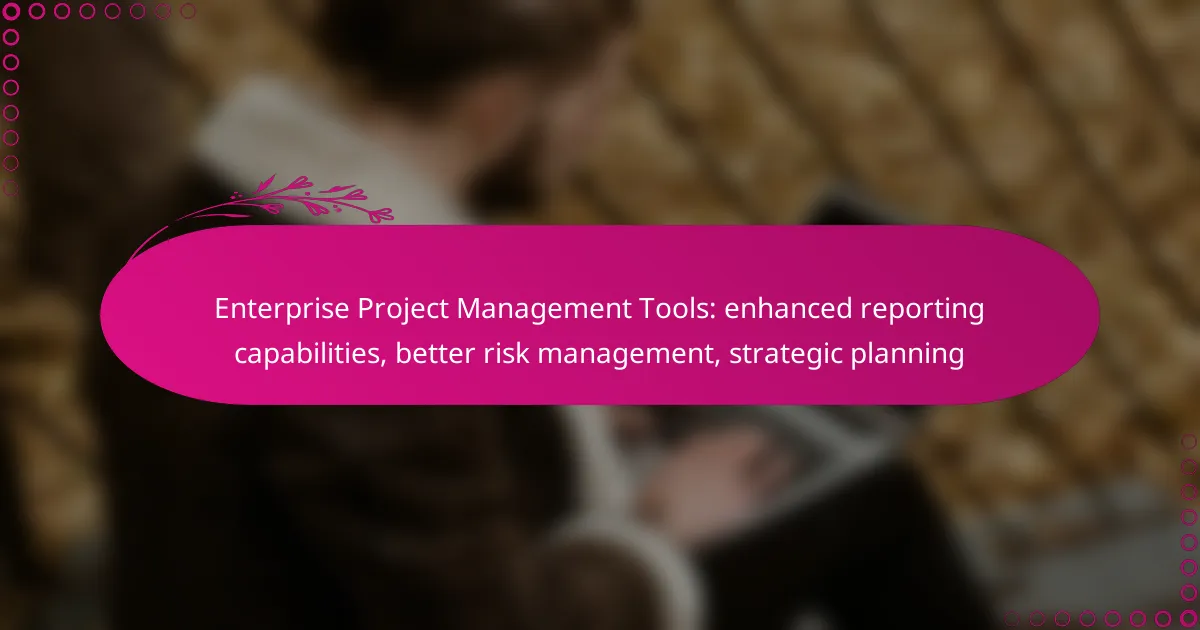Enterprise project management tools are essential for organizations seeking to enhance their reporting capabilities, improve risk management, and streamline strategic planning. With features like comprehensive data visualization and real-time analytics, these tools empower teams to make informed decisions and optimize project performance. Additionally, structured frameworks for risk assessment and effective resource allocation ensure that projects are completed on time and within budget.
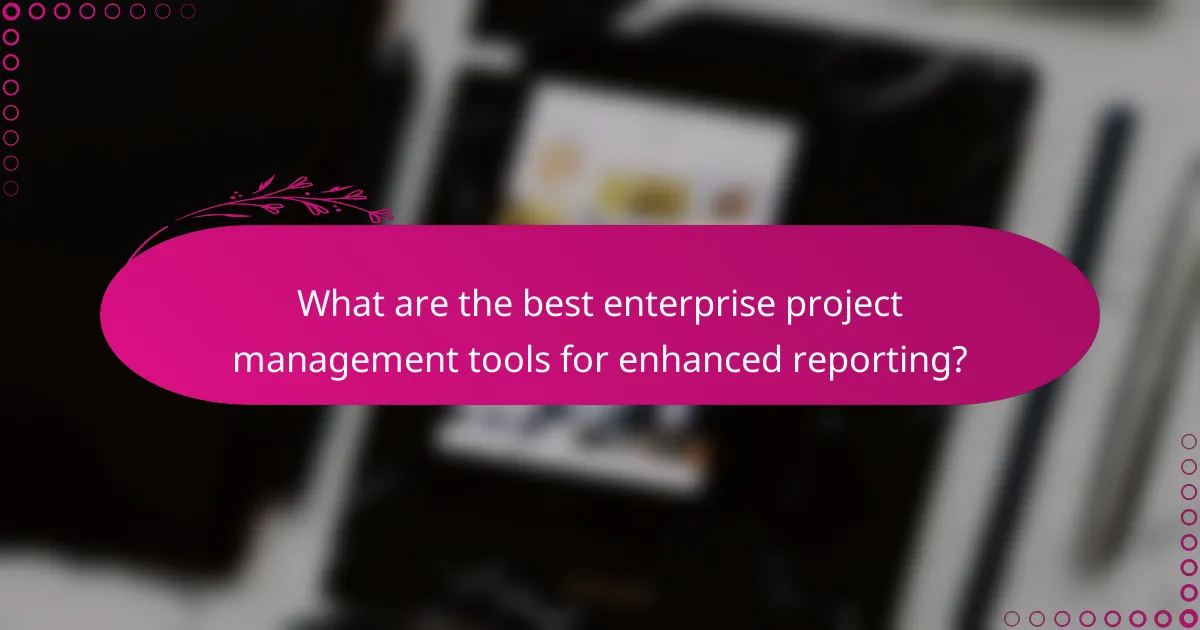
What are the best enterprise project management tools for enhanced reporting?
The best enterprise project management tools for enhanced reporting provide comprehensive data visualization, real-time analytics, and customizable reporting features. These tools help organizations track project performance, manage resources effectively, and make informed decisions based on actionable insights.
Microsoft Project
Microsoft Project is a robust tool that offers advanced reporting capabilities, allowing users to create detailed project reports and dashboards. It integrates seamlessly with other Microsoft applications, enabling users to leverage existing data for enhanced reporting.
Key features include Gantt charts, resource management tools, and customizable templates. Users can generate reports on project timelines, budgets, and resource allocation, making it easier to identify potential issues early.
Asana
Asana is known for its user-friendly interface and strong reporting functionalities. It allows teams to track project progress through visual dashboards and generate reports that highlight key metrics such as task completion rates and workload distribution.
With features like custom fields and project templates, Asana enables users to tailor reports to their specific needs. This flexibility helps teams stay aligned and informed about project status and performance.
Smartsheet
Smartsheet combines project management with powerful reporting tools, offering users the ability to create real-time reports and dashboards. Its spreadsheet-like interface makes it easy to manage data and generate insights quickly.
Users can automate reporting processes and customize views to focus on specific metrics. Smartsheet’s collaboration features also enhance communication, ensuring that all stakeholders have access to the latest project information.
Wrike
Wrike provides a comprehensive suite of reporting tools designed for enterprise-level project management. Its reporting features include real-time dashboards, customizable report templates, and advanced analytics capabilities.
With Wrike, users can track project performance against KPIs and generate reports that reflect team productivity and resource utilization. This helps organizations make data-driven decisions and optimize project outcomes.
Monday.com
Monday.com offers an intuitive platform with strong reporting capabilities that help teams visualize project data effectively. Users can create custom dashboards that display key performance indicators and project timelines at a glance.
The tool’s automation features streamline reporting processes, allowing teams to focus on analysis rather than data collection. With a variety of templates, Monday.com supports diverse reporting needs, making it suitable for various industries.

How do enterprise project management tools improve risk management?
Enterprise project management tools enhance risk management by providing structured frameworks for identifying, assessing, and mitigating risks throughout a project’s lifecycle. These tools facilitate proactive decision-making and enable teams to respond swiftly to potential issues.
Risk assessment features
Risk assessment features in enterprise project management tools allow teams to identify potential risks early in the project. These features often include risk scoring systems that evaluate the likelihood and impact of various risks, helping prioritize which risks need immediate attention.
For example, a tool might categorize risks as low, medium, or high based on predefined criteria, enabling project managers to allocate resources effectively. Utilizing these assessments can lead to more informed planning and resource allocation.
Real-time monitoring
Real-time monitoring capabilities enable project teams to track risk factors as they evolve. By continuously assessing project metrics and performance indicators, teams can quickly identify deviations from the plan that may signal emerging risks.
For instance, if a project’s budget is exceeding expectations, the tool can flag this as a potential financial risk, prompting immediate investigation and corrective action. This proactive approach helps maintain project stability and reduces the likelihood of significant issues arising.
Automated alerts
Automated alerts are critical for timely risk management, as they notify project stakeholders of potential risks or changes in status without manual intervention. These alerts can be configured based on specific triggers, such as budget overruns or missed deadlines.
By setting up alerts, project managers can ensure that the right team members are informed promptly, allowing for quicker responses. This feature minimizes the risk of overlooking critical issues and enhances overall project resilience.
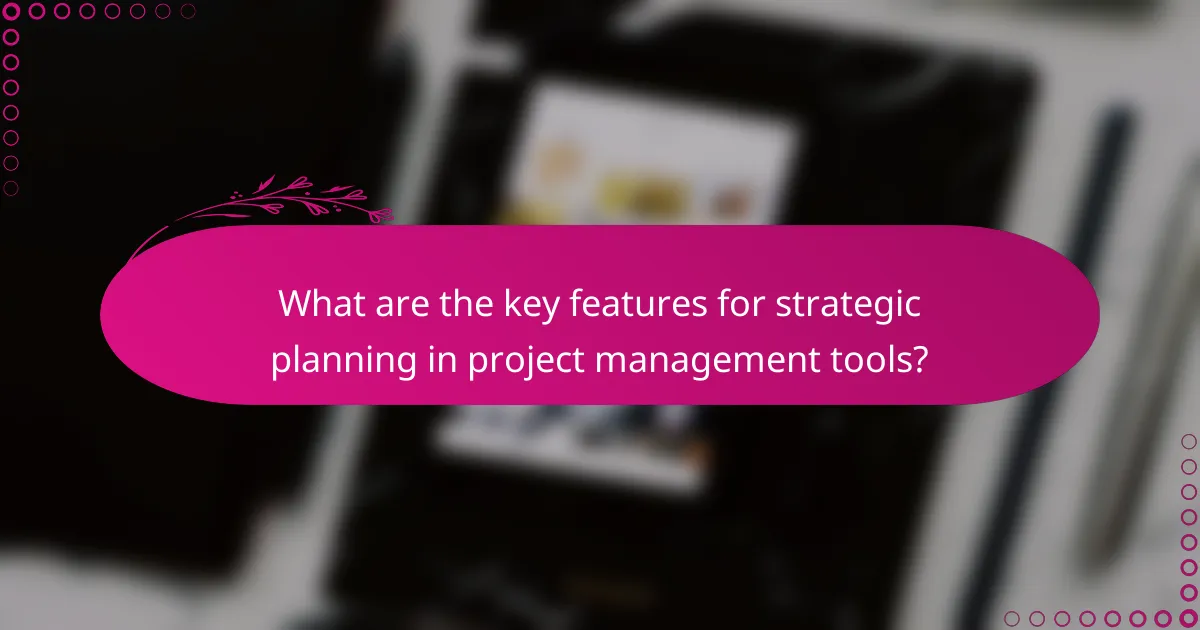
What are the key features for strategic planning in project management tools?
Key features for strategic planning in project management tools include resource allocation, budget tracking, and timeline visualization. These capabilities enable teams to optimize their workflows, manage financial resources effectively, and keep projects on schedule.
Resource allocation
Resource allocation involves assigning available resources—such as personnel, equipment, and time—to various project tasks. Effective tools allow project managers to visualize resource distribution, ensuring that workloads are balanced and that no team member is overburdened.
Consider using tools that provide real-time data on resource availability and utilization. This can help identify potential bottlenecks early, allowing for timely adjustments. For example, if a critical resource is over-allocated, the tool can suggest reallocating tasks to other team members with available capacity.
Budget tracking
Budget tracking is essential for maintaining financial control over projects. Project management tools should provide features to monitor expenses against the budget in real-time, allowing for quick identification of any discrepancies.
Look for tools that offer forecasting capabilities, enabling teams to predict future costs based on current spending trends. It’s useful to set alerts for when spending approaches budget limits, helping to avoid overspending. For instance, if a project budget is set at $50,000, tracking should allow for adjustments if costs exceed 70% of that budget.
Timeline visualization
Timeline visualization helps teams understand project schedules at a glance. Effective project management tools offer Gantt charts or similar visual aids that display task durations, dependencies, and milestones, making it easier to track progress.
When selecting a tool, ensure it allows for easy adjustments to timelines as project requirements change. This flexibility is crucial for managing delays or shifts in project scope. For example, if a task is delayed by a week, the tool should automatically update subsequent tasks to reflect the new timeline, helping teams stay aligned with project goals.
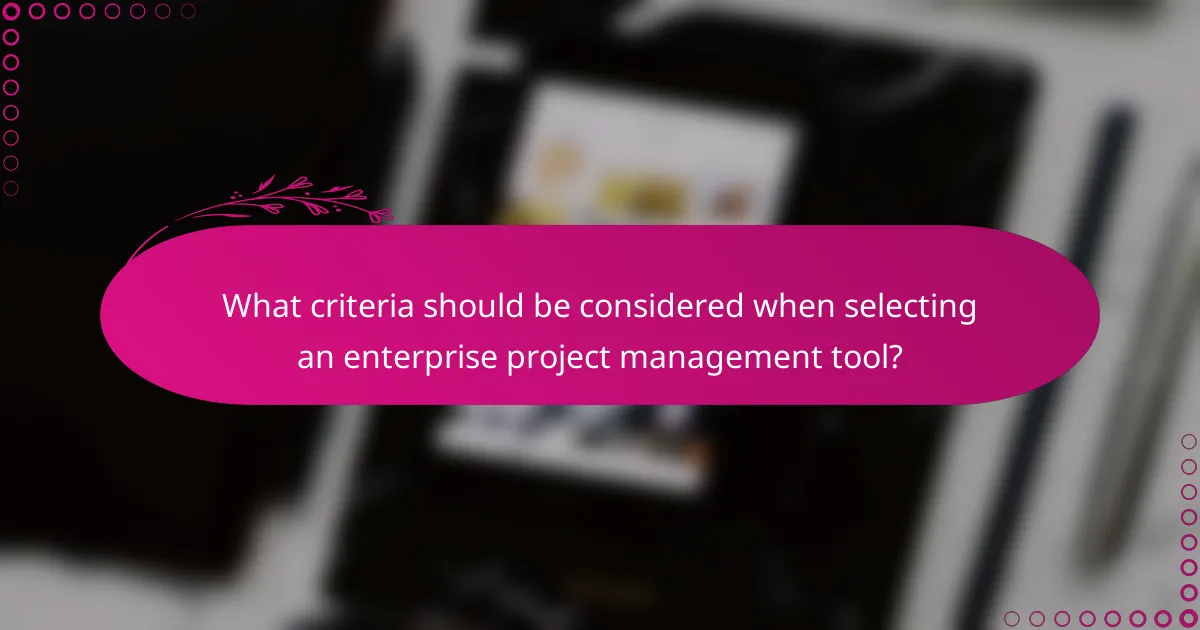
What criteria should be considered when selecting an enterprise project management tool?
When selecting an enterprise project management tool, consider integration capabilities, user interface, and scalability. These criteria ensure that the tool meets your organization’s needs and can adapt as projects evolve.
Integration capabilities
Integration capabilities refer to how well the project management tool connects with other software systems used within your organization. Look for tools that can seamlessly integrate with existing applications like CRM, ERP, and communication platforms to streamline workflows.
Evaluate the availability of APIs and pre-built connectors, as these can significantly enhance the tool’s functionality. A well-integrated tool can reduce manual data entry and improve overall efficiency.
User interface
A user-friendly interface is crucial for ensuring team adoption and effective use of the project management tool. A clean, intuitive design allows users to navigate easily and access features without extensive training.
Consider tools that offer customizable dashboards and visual reporting options, as these can help users quickly grasp project status and key metrics. A good user interface enhances collaboration and keeps teams engaged.
Scalability
Scalability is the ability of the project management tool to grow with your organization. As your projects expand in size and complexity, the tool should accommodate increased user numbers, project volumes, and additional features without performance degradation.
Assess whether the tool can handle larger teams and more intricate project structures. A scalable solution often includes tiered pricing plans, allowing you to pay for only what you need as your requirements evolve.
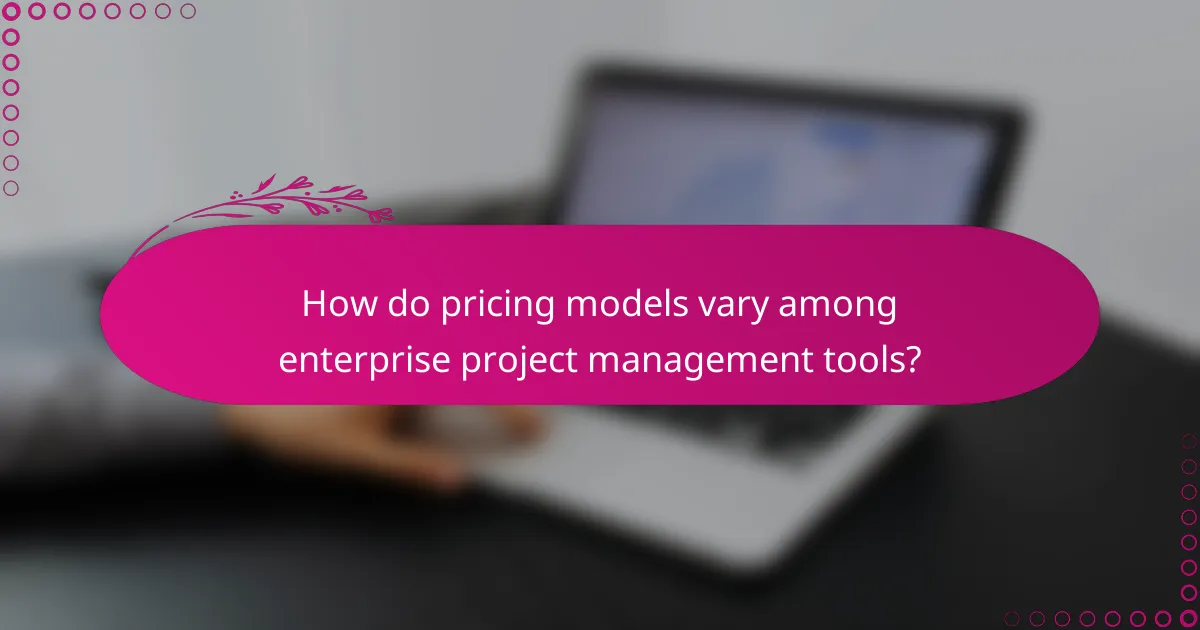
How do pricing models vary among enterprise project management tools?
Pricing models for enterprise project management tools can differ significantly, impacting how organizations budget for software. The most common models include subscription-based pricing, one-time licensing fees, and freemium options, each with its own advantages and considerations.
Subscription-based pricing
Subscription-based pricing is a popular model where organizations pay a recurring fee, typically monthly or annually, to access the software. This model often includes regular updates, support, and scalability, making it suitable for businesses that prefer predictable budgeting.
Costs for subscription-based tools can range from low tens of USD per user per month for basic features to higher amounts for advanced functionalities. Organizations should assess their usage needs and potential growth when selecting a subscription plan.
One-time licensing fees
One-time licensing fees require a single upfront payment for perpetual access to the software. This model can be advantageous for companies that prefer to avoid ongoing costs and have the resources to manage updates and support internally.
However, the initial investment can be significant, often ranging from several hundred to thousands of USD, depending on the tool’s complexity and features. Organizations should consider long-term costs, including maintenance and potential upgrades, when evaluating this option.
Freemium options
Freemium options allow users to access basic features of a project management tool at no cost, with the option to upgrade to a paid plan for advanced features. This model is beneficial for small teams or startups looking to test software before committing financially.
While freemium tools can provide essential functionalities, they often come with limitations, such as user caps or restricted features. Businesses should carefully evaluate whether the free version meets their needs or if upgrading is necessary for growth.
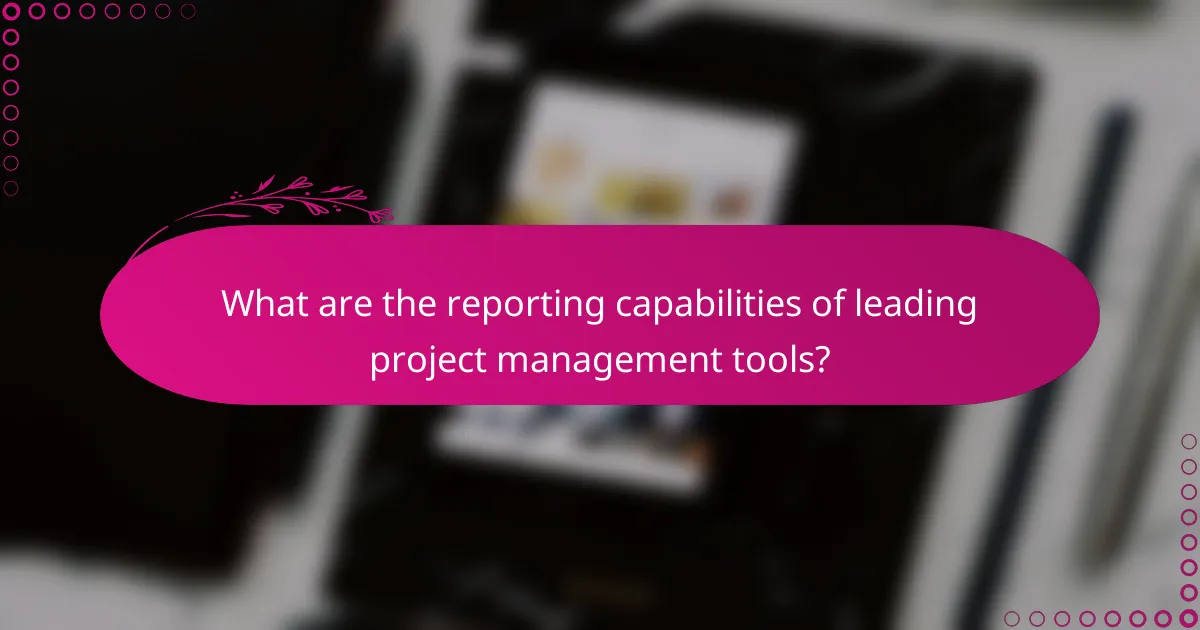
What are the reporting capabilities of leading project management tools?
Leading project management tools offer robust reporting capabilities that enable teams to track progress, analyze performance, and make informed decisions. These tools often feature customizable dashboards, real-time data visualization, and automated reporting functions that enhance transparency and accountability.
Enhanced Reporting Features
Enhanced reporting features in project management tools include customizable templates, visual data representations, and automated report generation. Users can create reports that focus on specific metrics such as task completion rates, budget adherence, and resource allocation. This flexibility allows project managers to tailor reports to meet the needs of stakeholders.
For instance, tools like Microsoft Project and Asana provide visual timelines and Gantt charts that help illustrate project progress. Such features facilitate better communication among team members and stakeholders, ensuring everyone is aligned with project goals.
Better Risk Management
Effective risk management is a critical component of project success, and leading tools offer features to identify, assess, and mitigate risks. Many platforms include risk assessment matrices and dashboards that allow teams to visualize potential risks and their impact on project timelines and budgets.
For example, tools like Trello and Jira enable users to categorize risks and assign them to team members for monitoring. Regularly updating risk assessments helps teams proactively address issues before they escalate, ultimately safeguarding project objectives.
Strategic Planning Capabilities
Strategic planning capabilities in project management tools help teams align their projects with broader organizational goals. Features such as portfolio management and resource planning allow project managers to prioritize initiatives based on strategic importance and available resources.
Tools like Smartsheet and Monday.com provide functionalities for tracking multiple projects simultaneously, enabling better resource allocation and strategic decision-making. By utilizing these capabilities, organizations can ensure that their projects contribute effectively to long-term objectives.
